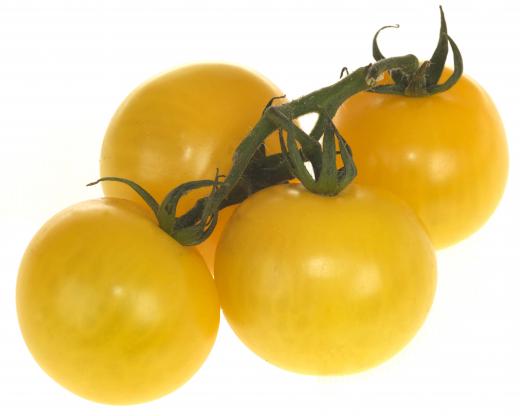Tomato farming takes place in a variety of locations, from simple backyard gardens to full agricultural industry operations spanning many acres. The best growing condition for tomatoes is a warm temperature. They are a particularly popular crop for small to medium sized farms because each tomato plant can produce over 10 pounds (4.5 kg) of fruit. The tomato farm industry has adapted to the specific needs and growing habits of the different breeds of tomato in order to produce them as efficiently as possible. Once harvested, tomatoes are then used for a multitude of purposes, being either sold raw or processed for use in many foods that utilize tomatoes.
Tomatoes originally came from South America, and they tend to thrive in warm climates that offer at least eight hours of full sunlight. Farmers will typically plant tomatoes once there is no fear of frost overtaking the crop. It is possible to grow tomatoes on a variety of soil makeups, but a deep and mildly acidic loam-type soil often yields the best results. While fertilizer is not necessary to grow tomatoes, a high phosphorous fertilizer can help them grow healthily and consistently.

There are a wide variety of tomato breeds, each requiring slightly different cultivation practices, and so tomato farming requires the farmer to have an understanding of the kind of tomato being grown. For example, midget tomatoes are typically grown in elevated containers that allow their dense vines to hang downwards, whereas beefsteak tomatoes, like most breeds, are grown directly from the ground. The first consideration in tomato farming is whether the growth habit of the crop is determinate or indeterminate. A crop of determinate tomato plant will, if grown properly and under proper conditions, blossom at the same time and generally be the same height as one another. Indeterminate tomato plants will blossom at different times throughout the growing season.

Once a farmer has harvested a crop of tomatoes, the way in which the fruit is sold will generally depend on the size of the operation. Smaller-sized tomato farming operations often sell their tomatoes to local establishments, farmer's markets, and even at a roadside stand. Larger tomato farming growers may sell their crop to a processing firm which will then prepares the tomatoes for sale in a number of different forms such as sauces and juices.
